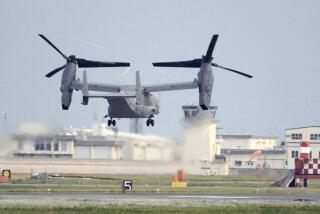Remains of U.S. Pilot Who Died in Korean War Are Identified
- Share via
WASHINGTON — Closing a curious chapter of Korean War history, the Pentagon announced Friday that it had identified the remains of an Air Force pilot whose jet crashed in Chinese territory after being shot down during a dogfight with a Soviet pilot flying for North Korea.
The case puts a spotlight on the Soviet Union’s role in the 1950-53 Korean war that was kept quiet for decades and helped feed speculation inside the American government that the Soviets had attempted -- and perhaps managed -- to capture U.S. pilots to exploit them for intelligence purposes.
Capt. Troy “Gordie” Cope of Norfork, Ark., was piloting an F-86 Sabre on Sept. 16, 1952, when he encountered MiG-15 fighters -- purportedly North Korean but flown by Soviets -- over the Yalu River that separates North Korea from China.
Cope, 28, was shot down and never seen again.
One of the Soviet Union’s highest intelligence collection priorities at the time was U.S. Air Force technology.
Cope was among 31 F-86 pilots lost and unaccounted for during the Korean War whom the Pentagon suspected had been captured and smuggled into the Soviet Union. Not all of those cases have been resolved, and Cope’s might not have been if not for a string of unusual fortune. In 1995, a U.S. businessman spotted Cope’s name on a dog tag on display in a military museum in Dandong, China.
In 1999, during a search by Pentagon analysts of Russia’s Podolsk military archives, documents describing Cope’s shoot-down were discovered. They included statements and drawings by Soviet pilots who had flown MiG-15s for the North Koreans in combat against the U.S.
Also in the documents were detailed reports about a search of the crash site by Soviet and Chinese officials. That gave the Pentagon enough details about the site to ask the Chinese government for permission to send a team of U.S. specialists to investigate. The site was excavated by U.S. officials in May; they recovered aircraft debris and human remains.
The remains were identified in October. In announcing the identification Friday, the Pentagon did not explain the delay in making it public. It is the first time that remains of a U.S. military pilot from the Korean War have been recovered from Chinese territory, although there have been other recent cases involving World War II and CIA missions.
Chinese soldiers fought on the North Koreans’ side against the U.S. and South Korean forces. The communist government in Beijing has balked at U.S. inquiries about the fate of missing U.S. servicemen.
Chris Cope, a nephew of the deceased pilot, said in a telephone interview that his uncle will be buried with full military honors May 31 in the Dallas area.
“It’s been a long, hard road,” he said. “I’m elated that we were able to get closure.”
In 1988, surviving relatives held a memorial service for Troy Cope in his hometown of Norfork “not knowing that we would ever be able to recover his remains,” Chris Cope said.
The Pentagon official in charge of POW/MIA affairs, Jerry Jennings, traveled to China to thank the Chinese for their cooperation in the case.
More to Read
Sign up for Essential California
The most important California stories and recommendations in your inbox every morning.
You may occasionally receive promotional content from the Los Angeles Times.













